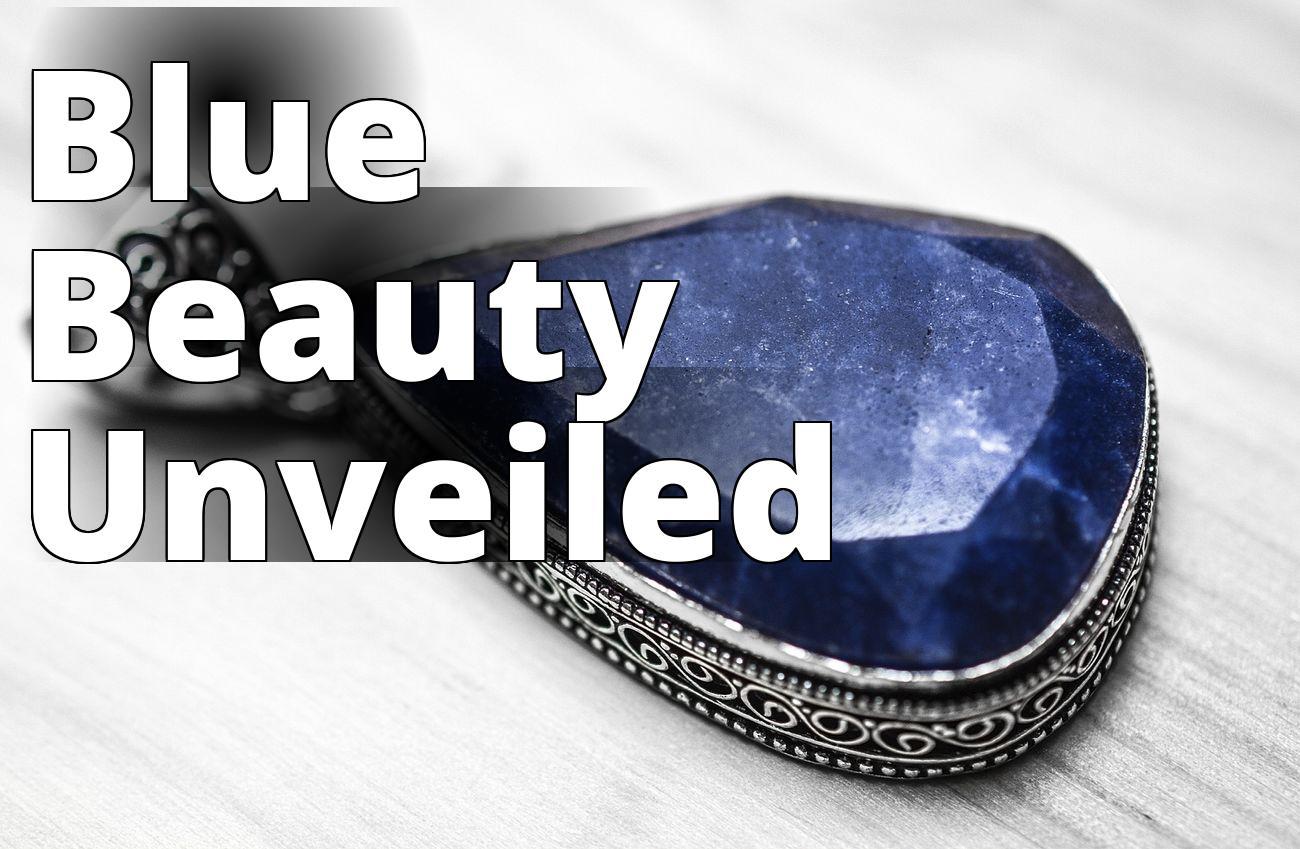What you will learn about sodalite:
- The history and significance of sodalite as a gemstone
- The physical characteristics and uses of sodalite in jewelry and decoration
- The healing properties and metaphysical uses of sodalite, as well as its association with the throat chakra
- How to identify sodalite and care for sodalite jewelry
- Interesting facts and trivia about sodalite, including its fluorescence and tenebrescence properties
- The differences between sodalite and lapis lazuli, two similar blue gemstones
Are you curious about sodalite, the royal blue gemstone known for its mesmerizing beauty and unique properties? In this article, we will explore the wonders of sodalite, from its origin and physical characteristics to its metaphysical properties and decorative applications. Discover how sodalite can add elegance to your jewelry collection and bring balance to your mind, body, and spirit.

Origin and Discovery
Sodalite, a captivating gemstone, was first discovered in Greenland in 1811 by the Danish mineralogist, Thomas Thomson. However, it wasn’t until 1891 that large deposits of sodalite were found in Canada, specifically in Ontario and Quebec. This discovery marked a significant turning point for sodalite, as it brought this beautiful gemstone into the spotlight and made it more accessible for jewelry and decorative purposes.

Physical Characteristics
Sodalite is renowned for its striking royal blue color, ranging from deep navy blue to lighter shades of blue. While royal blue is the most well-known color of sodalite, it can also occur in other variations such as gray, green, and yellow. These variations are less common but are equally captivating and can be used in various ornamental applications.
In terms of transparency, sodalite crystals can be transparent or translucent. The gemstone exhibits a vitreous to greasy luster, adding to its allure.
| Physical Characteristics | Gemstone and Decorative Uses |
|---|---|
| Striking royal blue color | Adds elegance to jewelry |
| Can occur in variations such as gray, green, and yellow | Used in sculptures and ornamental objects |
| Transparent or translucent crystals | Cut into various shapes for different settings |
| Exhibits vitreous to greasy luster | Paired with silver or white gold settings for contrast |

Gemstone and Decorative Uses
Sodalite’s captivating color and unique properties make it highly sought-after for jewelry making and decorative applications. The royal blue hue of sodalite adds elegance and sophistication to any piece of jewelry. It is often used in the creation of rings, necklaces, bracelets, and earrings.
Sodalite can be cut into various shapes, such as cabochons, beads, and faceted stones, to showcase its beauty in different settings. The deep blue color of sodalite is often paired with silver or white gold settings to create a stunning contrast that enhances its visual impact.
Apart from jewelry, sodalite is also used in decorative applications. Its vibrant blue color can be incorporated into sculptures, vases, and other ornamental objects, adding a touch of elegance and beauty to any space.

Healing Properties and Metaphysical Uses
Sodalite is not just visually appealing; it also possesses various metaphysical properties that are believed to bring balance and harmony to the mind, body, and spirit. This gemstone is known to promote order, calmness, and rational thought, making it an excellent tool for enhancing mental clarity and focus.
When it comes to emotional healing, sodalite is believed to enhance intuition and self-esteem. It encourages introspection and self-awareness, allowing individuals to tap into their inner wisdom and make decisions with confidence. Sodalite is also associated with the throat chakra, which governs communication and self-expression. It is thought to support clear and effective communication, making it a beneficial gemstone for public speakers, singers, and writers.
Furthermore, sodalite is said to have physical healing properties. It is believed to boost the immune system and alleviate throat and digestive disorders. By promoting a sense of calmness and balance, sodalite can help reduce stress and anxiety, which are often associated with physical ailments.
Geological Formation
Sodalite is primarily found in igneous rocks, especially in association with minerals such as nepheline, feldspar, and pyroxene. Its unique structure allows it to act as a container material for various anions, making it a fascinating gemstone from a geological perspective.
Unlike other similar minerals like haüyne and nosean, sodalite is virtually CO2-free. This distinction adds to the rarity and uniqueness of sodalite. The composition and formation of sodalite are complex processes that occur over millions of years, resulting in the creation of this exquisite gemstone.
Identifying Sodalite
Identifying sodalite can be done based on its physical properties and crystal structure. Sodalite typically has a distinct royal blue color, which sets it apart from other blue gemstones. Its transparency or translucency, coupled with its vitreous to greasy luster, can help identify it further.
Sodalite often forms in isometric crystals, which have a cubic or octahedral shape. However, it can also occur in massive or granular forms. Its distinctive crystal structure, along with its unique color and composition, make sodalite a gemstone that is easily recognizable for those familiar with its characteristics.
It is worth noting that sodalite is sometimes mistaken for lapis lazuli due to their similar blue color. However, sodalite is more affordable and has a different mineral composition, making it a distinct gemstone in its own right.
Valuation and Care
The value of sodalite in the gemstone market is determined by various factors, including color intensity, clarity, and size. The most highly valued sodalite gemstones exhibit a deep, intense royal blue color with good transparency. Clarity is also important, with fewer inclusions leading to higher value.
To care for sodalite jewelry and maintain its beauty, it is essential to handle it with care. Sodalite has a hardness rating of 5.5 to 6 on the Mohs scale, which means it is relatively soft compared to other gemstones. Avoid exposing sodalite to harsh chemicals and extreme temperatures, as these can cause damage to the gemstone.
When storing sodalite jewelry, it is best to keep it separate from other gemstones to prevent scratches. Gently clean sodalite with warm, soapy water and a soft brush, and dry it thoroughly with a clean cloth. By following these simple care instructions, you can ensure that your sodalite jewelry remains beautiful for years to come.
Personal Story: The Calming Power of Sodalite
I want to share a personal experience that highlights the healing properties of sodalite. A few years ago, my friend Emily was going through a particularly challenging time in her life. She was feeling overwhelmed, anxious, and struggling to find balance.
One day, while browsing through a local gemstone shop, Emily came across a beautiful sodalite pendant. Drawn to its vibrant blue color, she decided to purchase it and wear it as a necklace.
To her surprise, Emily started noticing a significant shift in her mood and overall well-being. She described feeling a sense of calmness and tranquility whenever she wore the sodalite pendant. It seemed to help her regain her focus and think more clearly, allowing her to approach her challenges with a rational and balanced mindset.
Intrigued by her experience, Emily decided to do some research on sodalite’s metaphysical properties. She discovered that sodalite is believed to promote order and organization, which explained why she felt more in control of her thoughts and emotions while wearing the pendant.
Emily also learned that sodalite is associated with the throat chakra, which is believed to govern communication and self-expression. This resonated with her, as she had been struggling to find her voice and speak her truth during that difficult time.
Inspired by her personal experience, Emily began incorporating sodalite into her daily life. She placed sodalite stones on her desk while working and kept a sodalite palm stone in her pocket for moments when she needed a calming presence.
Through her journey with sodalite, Emily discovered the power of gemstones in enhancing emotional well-being and promoting inner balance. Today, she continues to rely on sodalite as a tool for self-care and personal growth, and she encourages others to explore its healing properties as well.

Interesting Facts and Trivia
Sodalite possesses several fascinating properties that make it truly unique. One notable characteristic of sodalite is its fluorescence. Under ultraviolet light, sodalite may exhibit a vibrant orange glow, adding an enchanting element to its allure.
Another intriguing property of sodalite is its tenebrescence. When exposed to shortwave ultraviolet light, sodalite can temporarily change color. For example, a blue sodalite specimen may turn pink or purple. This phenomenon, known as reversible photochromism, adds an element of surprise and wonder to sodalite’s already captivating nature.
Throughout history, sodalite has been used for various purposes. In ancient Egypt, sodalite was associated with the goddess Isis and was believed to bring inner peace and spiritual awakening. It has also been used by Native American tribes as a sacred stone for rituals and ceremonies.
Sodalite vs. Lapis Lazuli: A Comparison
Sodalite and lapis lazuli are two blue gemstones that are often mistaken for each other due to their similar appearance. While they share some similarities, such as their rich blue color, they have distinct characteristics that set them apart.
Sodalite is primarily composed of sodium cations and chloride anions, while lapis lazuli contains a combination of minerals, including lazurite, calcite, and pyrite. This difference in mineral composition gives each gemstone its unique properties and appearance.
Another distinguishing factor is the price. Sodalite is generally more affordable compared to lapis lazuli, making it a popular choice for those seeking a vibrant blue gemstone without the higher price tag.
Conclusion
Sodalite is a truly remarkable gemstone that combines exceptional beauty with metaphysical properties. Whether you are drawn to sodalite for its vibrant royal blue color, its ability to promote calmness and rational thought, or its unique geological formation, this gemstone holds a special place in the world of gemstones and crystals. Incorporating sodalite into your jewelry collection or using it to enhance your living space can bring a sense of elegance, serenity, and balance to your life.
Uncover the wonders of sodalite and experience the beauty and benefits this extraordinary gemstone has to offer.
References:
– Sodalite – Wikipedia
– Sodalite Healing Properties | Sodalite Meaning | Benefits Of Sodalite…







